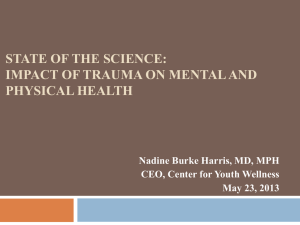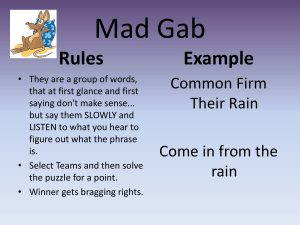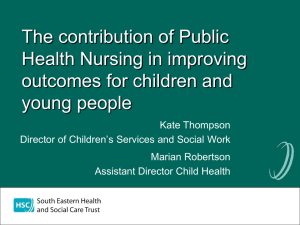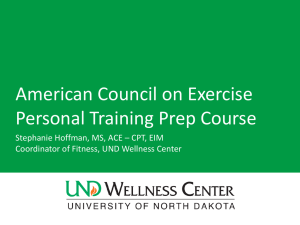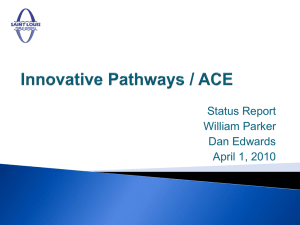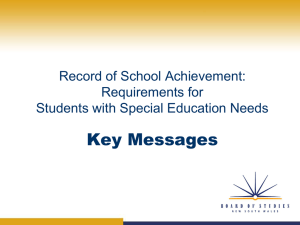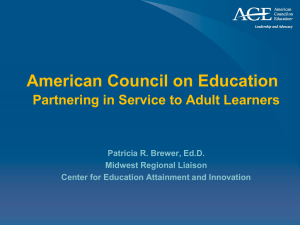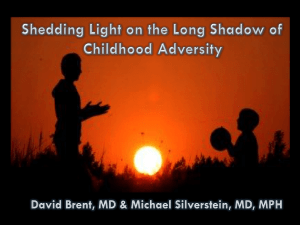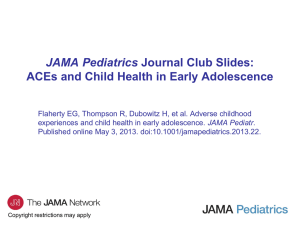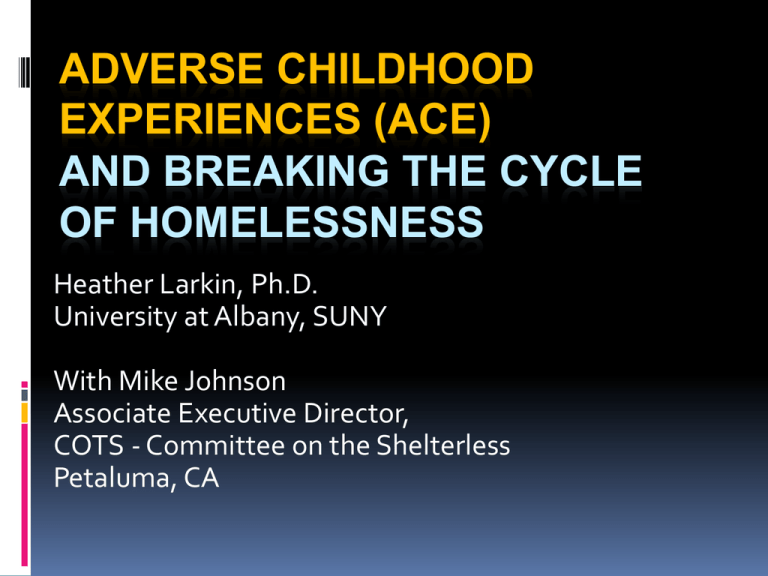
ADVERSE CHILDHOOD
EXPERIENCES (ACE)
AND BREAKING THE CYCLE
OF HOMELESSNESS
Heather Larkin, Ph.D.
University at Albany, SUNY
With Mike Johnson
Associate Executive Director,
COTS - Committee on the Shelterless
Petaluma, CA
The Committee on the Shelterless
(COTS)
Comprehensive, integrated programming
ACE research w/ Heather
Using resilience & recovery knowledge
Develop a “whole person” approach
(www.cots-homeless.org)
Leadership & culture
COTS’ Mission
Our mission is to
break the cycle of
homelessness
for children, their
families and
single adults
without children
in their care
COTS Agency Overview
•500 individuals at the Mary Isaak Center, 50 adults in Transitional Housing
•44 families each year in Shared Transitional Housing
•COTS provides 100,000 bednights a year, 110,000 meals, and delivers
700,000 lbs of food to the community
Family Programs
Food Programs
Adult Programs
•MIC Family Center
•Mary Isaak Center, ES
(35 beds family TH)
•Petaluma Kitchen
(110,000 meals/yr)
•7 Shared
Transitional Homes
•Food Box Program
(700,000 lbs/yr)
•4 Shared Transitional
(60 beds)
(12 beds PSH)
(12 Beds single family
transitional housing)
(75 beds PSH)
Homes (32 beds)
•3 Integrity Houses
•3 Intention Houses
•Vida Nueva
(100 Beds emerg. shelter)
Integrated Programs
How do we become
homeless?
Homelessness, Trauma & Recovery
ACEs, adult experiences, homelessness
Risk behaviors as solutions
People are not the sum of their problems
Body/Mind/Spirit
Leverage strengths & resilience
The Adverse Childhood Experiences
(ACE) Study
Summary of Findings:
• (ACEs) are very common
• ACEs are strong predictors of adult
health risks and disease
• ACEs are implicated in the 10 leading causes of
death in the U.S.!
• “I was actually stunned and I wept over what I
saw.” ACEs researcher Rob Anda, M.D.
•
Virtually every study shows that ACEs are strong
predictors of homelessness (Burt, 2001)
What are ACEs? (10 categories)
Adverse Childhood Experiences
1. Sexual abuse before age 18
2. Emotional abuse by parent or loved one
3. Physical abuse by parent or loved one
4. Emotional neglect by parent or loved one
5. Physical neglect by parent or loved one
6. Loss /abandonment of or by parent
7. Witnessed abuse of a loved one
8. Drug/alcohol abuse in the household
9. Mental illness in the household
10. Loved one incarcerated
Adverse Childhood Experiences Score
• Original ACE Study
• More than half have at least one ACE
• > than 25% have 2 – 4 ACE categories
• 1997: ACEs & Homelessness Risk
• Lack of care + abuse = increase risk by factor of 26
• Any ACE increased risk by factor of 8
• Current Homeless Respondents
• > 85% ACE Score of 1 or higher
• > half (52.4%) ACE Score > than 4
Adverse Childhood Experiences
vs. Current Smoking
20
18
16
14
12
%
10
8
6
4
2
0
0
1
2
3
ACE Score
4-5
6 or more
18
Childhood Experiences vs.
Adult Alcoholism
16
4+
% Alcoholic
14
12
3
10
2
8
6
1
4
2
0
0
ACE Score
% With a Lifetime History of
Depression
Childhood Experiences
Underlie Chronic Depression
80
70
60
50
40
30
20
Women
Men
10
0
0
1
2
ACE Score
3
>=4
Childhood Experiences
Underlie Suicide
25
4+
% Attempting Suicide
20
15
3
10
2
5
0
1
0
ACE Score
Ever Hallucinated* (%)
ACE Score and Hallucinations
12
Abused
Alcohol
or Drugs
10
8
No
Yes
6
4
2
0
0
1
2
3
4
5
6
>=7
ACE Score
*Adjusted for age, sex, race, and education.
ACE Score vs. Intravenous Drug Use
% Have Injected Drugs
3.5
3
2.5
2
1.5
1
0.5
0
0
1
2
3
4 or more
ACE Score
N = 8,022
p<0.001
% with Job Problems
ACE Score vs.
Serious Job Problems
18
16
14
12
10
8
6
4
2
0
0
1
2
ACE Score
3
4 or more
Causes of Homelessness
Interior Individual:
INDIVIDUAL
Exterior Individual:
•Substance abuse
•Overwhelming emotions
•Disruptive behaviors
•Derailed psychological
development
•Inability to hold a job
•Poor Health/ illness/ injury
•Cognitive deficits
•Poor self-esteem
Interior Collective:
Exterior Collective:
•Lack of supports
Family relational system/ACEs
•Inter-subjective stories of
failure
•Lack of jobs
•Lack of affordable housing
•Victim blaming in larger
culture
•Inadequate access to
insurance or treatment
•Poverty, social violence
COLLECTIVE
EXTERIOR OBJECTIVE
INTERIOR SUBJECTIVE
•ACE impact on developing self
OK,
SO WHAT CAN WE DO
ABOUT IT?
Know what you can and can’t do
For most providers, long-term therapy for
clients is not an option
More effective to work with behaviors that
result from ACES
You can shift culture to change behavior!
Promoting Resilience,
Recovery, and Transformation
"...everything can be taken from a
man but one thing: the last of the
human freedoms -- to choose one's
attitude in any given set of
circumstances, to choose one's
own way."
- Victor Frankl
COTS’ Organizational Development
• “ACE-informed” programming
• ACE awareness in agency culture
• ACE-informed vs. trauma-informed
• Mobilization of resilience, recovery &
transformation
• Staff engagement
• Best practices
• Articulation of values & principles
• Connection, Hope, Intention, Integrity
• The Four Agreements
• Leadership sets an example
Resilience & Recovery
Resiliency research (Frankl)
Individual & community support each other
a personal connection with someone who believes in
him/her
a sense that others have high expectations of
him/her
Growth = Challenge + Support
opportunities to make choices – find purpose
Recovery
Identity, attitude, values, goals are all strengthened
and shaped by resilience
Culture & workforce
Compassionate culture
Personal development of staff with ACE scores
Therapeutic community for clients recovering from
ACEs (and other trauma)
Staff builds relationships and models behavior
Self care needed – Empathy is risky!
Prevention of vicarious traumatization
Rest, renewal, development
Builds staff resilience!
Policies in support of culture
Health & safety prioritized
Creates a welcoming environment
No use drug & alcohol policy
Random and for cause testing for all
Clear rules & expectations
Extends into the community – mirrors community
values
COTS’ ACE Response
Supporting the “I” space
•More positive Explicatory Narrative
INTERIOR SUBJECTIVE
•Intention, plans and goals, using motivational interviewing
•New coping skills for anger, stress and grief
•Meditation
•Yoga Nidra / Chi Gung (At Home Within offered with IONS)
•Recovery from psychological component of addictions
•Relapse prevention skills building
Rent Right, Work Right
•Life skills:
Kids First
Money Smart
INDIVIDUAL
ACE-informed Programming
Supporting the “IT” space
•Meet basic needs (Maslow’s Hierarchy)
•Medical
•Dental
•Trauma (Somatic Experiencing; volunteers)
•Acupuncture (volunteers)
•AA/NA recovery from physical aspects of addiction
INDIVIDUAL
EXTERIOR OBJECTIVE
•Work with the body in support of healing through onsite clinics
ACE-informed Programming
Supporting the “WE” space
INTERIOR SUBJECTIVE
•Therapeutic and learning communities
•Culture of recovery and transformation
•Connection with faith communities
•Peer support groups
•Mentoring from senior program participants
•Working in groups, classes and workshops on
common goals
•Reconnection with community through community
service
COLLECTIVE
ACE-informed Programming
Supporting the “ITS” space
• Rules of Decorum
• Intake procedure and requirements
• Drug / alcohol testing
•Shelter Management System to manage the programs
and participants’ data
•Case management wiki supports service delivery and
collaboration among service providers
COLLECTIVE
EXTERIOR OBJECTIVE
•Policies and procedures support program culture
HEARTS trump ACEs
•
•
•
•
•
•
Healthy
Environments
And
Relationships
That
Support
Promotes individuals’ strength and resiliency,
preventing and intervening with ACEs –
happens mostly in the LL and LR quadrants
Results of ACE Informed Programs
ACE knowledge + Program Development
+ Culture = Results!
- In 2004 – 2005, COTS housed .01% (8 of 646) single
adults with the same # of staff in drop-in center and
winter shelter programs
- In 2008 – 2009, 48% (283 of 590) unduplicated
individuals were successfully housed in transitional or
permanent housing with ACEs informed programming
at the Mary Isaak Center.
Questions?


